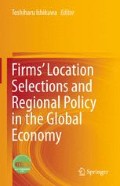Abstract
This chapter gives an exploratory description of the spatial distribution of relative local tax bases and private wealth as well as the growth rate in these variables across Swedish municipalities during the period 1992–2013. The main aim is to test the hypothesis that municipalities with relatively high tax bases and high private wealth, such as relative capital incomes or private property values and changes in these variables, are more spatially clustered than could be caused by pure chance. The chapter is purely descriptive where we make use of two frequently used statistical tests for spatial correlation, the global Moran’s I and the local G * i (d)-statistic, as well as maps to identify what we refer to as regional ‘hot spots’. That is, clusters of municipalities with high local tax bases and private wealth in combination with high growth rates in these variables. This chapter also serves as a guide to how the global Moran’s I and the local G * i (d)-statistic could be used with application to the spatial distribution of local tax bases and private wealth across Swedish municipalities. Even though this paper focuses on local tax bases and private wealth, the method applied could of course be used to identify other types of clusters such as industrial clusters, clusters of individuals and/or industries with specific human capital and knowledge, different types of crimes, etc.
The author would like to thank Sofia Lundberg and Krister Sandberg for comments on previous versions of this paper.
Access this chapter
Tax calculation will be finalised at checkout
Purchases are for personal use only
Notes
- 1.
A more in-depth discussion and description of the spatial weights matrices used in this paper is given in the section Definition of Neighbors below.
- 2.
\( SD(I)=\sqrt{E{\left[I\right]}^2-E{\left[I\right]}^2} \) where \( E{\left[I\right]}^2=\frac{A-B}{C} \); \( A=n\left[\left({n}^2-3n+3\right){S}_1-n{S}_2+3{S}_0^2\right] \); \( B=D\left[\left({n}^2-n\right){S}_1-2n{S}_2+6{S}_0^2\right] \); \( C=\left(n-1\right)\left(n-2\right)\left(n-3\right){S}_0^2 \); \( D=\frac{{\displaystyle {\sum}_{i=1}^n}{z}_i^4}{{\left({\displaystyle {\sum}_{i=1}^n}{z}_i^2\right)}^2} \); \( {S}_0={\displaystyle \sum_{i=1}^n}{\displaystyle \sum_{j=1}^n}{w}_{ij} \); \( {S}_1=\frac{1}{2}{\displaystyle \sum_{i=1}^n}{\displaystyle \sum_{j=1}^n}{\left({w}_{ij}+{w}_{ji}\right)}^2 \); and \( {S}_2={\displaystyle \sum_{i=1}^n}{\left({\displaystyle \sum_{j=1}^n}{w}_{ij}+{\displaystyle \sum_{i=1}^n}{w}_{ji}\right)}^2 \).
- 3.
Most commonly, the 95 % level of significance is used to evaluate the significance of econometric test statistics. However, as we will later use the 99 % level of significance when calculating the G * i (d) -statistics in order to single out the most significant regions, we use the same level of significance when evaluating the Moran’s I.
- 4.
Here \( SD\left[{G}_i^{*}(d)\right]=\sqrt{V\left[{G}_i^{*}(d)\right]}=\sqrt{\frac{W_i^{*}\left(n-{W}_i^{*}\right){Y}_{i2}^{*}}{n^2\left(n-1\right){\left({Y}_{i1}^{*}\right)}^2}} \) where \( {Y}_{i1}^{*}=\frac{{\displaystyle {\sum}_{j=1}^n}{y}_j}{n} \) and \( {Y}_{i2}^{*}=\frac{{\displaystyle {\sum}_{j=1}^n}{\displaystyle {\sum}_{i=1}^n}{\left({y}_i{y}_j\right)}^2}{n}-{\left({Y}_{i1}^{*}\right)}^2 \).
- 5.
\( E\left[{G}_i^{*}(d)\right]=\frac{{\displaystyle {\sum}_{i=1}^n}{\displaystyle {\sum}_{j=1}^n}{w}_{ij}}{n\left(n-1\right)} \); \( V\left[{G}_i^{*}(d)\right]=E\left[{\left({G}_i^{*}(d)\right)}^2\right]-E{\left[{G}_i^{*}(d)\right]}^2 \).
- 6.
The local tax base is in principle the sum of all inhabitants’ income from work.
- 7.
The federal capital tax income comes from a 30 % tax on personal incomes from interest rates, dividends, and net profits from property sales.
- 8.
The private property tax is a federal tax on an estimated market price on private housing and private apartments.
- 9.
See Lundberg (2014) for a discussion regarding the definition of W when testing for yardstick competition.
- 10.
See Qu and Lee (2015) for estimation of spatial autoregressive models with an endogenous spatial weights matrix.
References
Anselin, L. (1988). Spatial econometrics: Methods and models. Dordrecht: Kluwer.
Aronsson, T., Lundberg, J., & Wikström, M. (2001). Regional income growth and net migration in Sweden 1970–1995. Regional Studies, 35(9), 823–830.
Burridge, P. (1980). On the Cliff-Ord test for spatial correlation. Journal of the Royal Statistical Society B, 42, 107–108.
Cliff, A., & Ord, J. K. (1972). Testing for spatial autocorrelation among regression residuals. Geographical Analysis, 4, 267–284.
Getis, A., & Ord, J. K. (1992). The analysis of spatial association by use of distance statistics. Geographical Analysis, 24, 189–206.
Keleijan, H. H., & Prucha, I. R. (2001). On the asymptotic distribution of the Moran I test statistic with applications. Journal of Econometrics, 104, 219–257.
Lundberg, J. (2003). On the determinants of average income growth and net migration at the municipal level in Sweden. The Review of Regional Studies, 33(2), 110–134.
Lundberg, J. (2006). Using spatial econometrics to analyze local growth in Sweden. Regional Studies, 40(03), 303–316.
Lundberg, J. (2014). On the definition of W in empirical models of yardstick competition. Annals of Regional Science, 52(2), 597–610.
Moran, P. (1948). The interpretation on statistical maps. Journal of the Royal Statistical Society B, 10, 243–251.
Ord, J. K., & Getis, A. (1995). Local spatial autocorrelation statistics: Distributional issues and an application. Geographical Analysis, 27(4), 286–305.
Persson, J. (1997). Convergence across the Swedish counties, 1911–1993. European Economic Review, 41, 1834–1852.
Pinkse, J. (1999). Asymptotic properties of Moran and related tests and testing for spatial correlation in probit models. Department of Economics, University of British Columbia and University College, London.
Qua, X., & Lee, L. (2015). Estimating a spatial autoregressive model with an endogenous spatial weight matrix. Journal of Econometrics, 184, 209–232.
Author information
Authors and Affiliations
Corresponding author
Editor information
Editors and Affiliations
Rights and permissions
Copyright information
© 2015 Springer Japan
About this chapter
Cite this chapter
Lundberg, J. (2015). The Spatial Distribution of Wealth: A Search for Hot Spots. In: Ishikawa, T. (eds) Firms’ Location Selections and Regional Policy in the Global Economy. Springer, Tokyo. https://doi.org/10.1007/978-4-431-55366-3_11
Download citation
DOI: https://doi.org/10.1007/978-4-431-55366-3_11
Publisher Name: Springer, Tokyo
Print ISBN: 978-4-431-55365-6
Online ISBN: 978-4-431-55366-3
eBook Packages: Business and EconomicsEconomics and Finance (R0)

